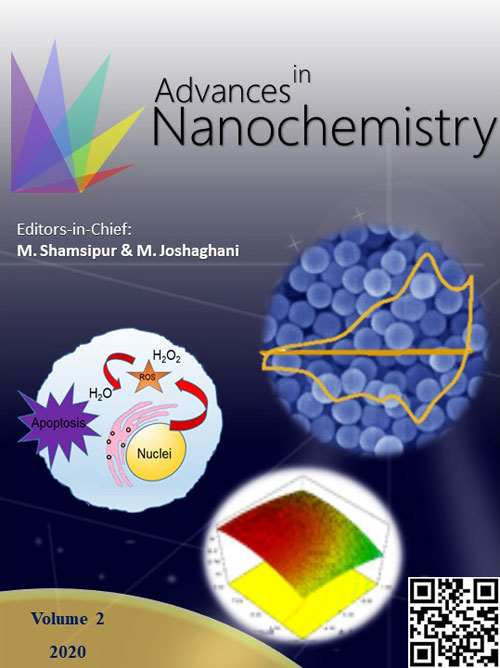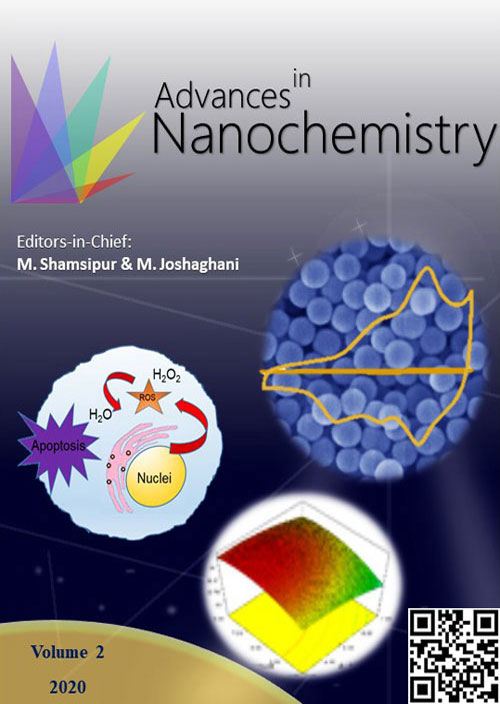فهرست مطالب

Advances in Nanochemistry
Volume:2 Issue: 1, Winter and Spring 2020
- تاریخ انتشار: 1398/10/11
- تعداد عناوین: 7
-
Pages 1-6
A series of nanocatalysts based on heteropoly acid supported on various nanomaterials such as metal-organic frameworks (MOFs), carbon- and silica-based materials, have been synthesized for application in the esterification of oleic acid as catalyst. The effects of multiple parameters and their reciprocal interactions were investigated using a five-level three-factor design. The reaction conditions such as catalyst amount, methanol to oleic acid molar ratio, and reaction temperature have been optimized by Response Surface Methodology using the Central Composite Design model. The reaction temperature was the most significant factor, and the best conversion ratio of oleic acid could reach 99.27% with 5.97% of catalyst amount and 3.90:1 of methanol to oleic acid molar ratio at 74.0 °C. As a preliminary application, the best nanocatalyst was used in biodiesel production from castor oil and methanol. The yields of fatty acid methyl esters for castor oil were about 90.2%.
Keywords: Biodiesel, Nanocatalyst, Heteropoly acid, Response Surface Methodology, Castor Oil -
Pages 7-10Design and synthesis of new and high-performance electrode materials are the tasks of scientists to respond to the increasing demand for efficient renewable energy storage devices. Herein, we developed a spinel nickel-manganese-cobalt ternary oxide (NMCO) spheres by a facile approach with a hollow-interior nanoporous shell possessing a high specific surface area of 67 m2 g-1 and pore size distribution of about 8 nm as a high-performance electrode material for supercapacitor applications. This electrode delivers ultrahigh specific capacitance of 1372 F g−1 at 2 A g−1 (4.1 F cm−2 at 6 mA cm−2) with remarkable rate capability of 55% after increasing the current density from 2 A g−1 (6 mA cm−2) to 60 A g−1 (180 mA cm−2), excellent cycling stability of 91.2% after 10000 continues charge/discharge cycles at 15 mA cm−2, and maximum energy density of 38.6 Wh kg−1. This work sheds further light on the design and development of high-performance electrode materials not only for energy storage applications but also for other electronic devices.Keywords: Nanoporous, Spinel, Ternary oxide, Hollow spheres, Supercapacitor
-
Pages 11-14Hydroxyapatite (HAp), the main calcium phosphate and the most inorganic compounds in hard tissues, exhibits sound cytocompatibility and osteogenic activity for clinical bone replacement and tissue engineering. HAp nanostructures depict the more special characteristics than HAp microstructures in various features such as physical, chemical and biological properties. Besides, outstanding characteristics of HAp in bone tissue engineering, recently, inhibitory effects of nanoscaled HAp in different tumor cells proliferation and especially breast cancer was fully detailed and discussed in the literature. Here for the first time, we propose the capability of three needle, spherical, and mesoporous HAp nanoparticles for inhibition of cancer cell proliferation in vitro. The comparison of the three morphologies of HAp nanoparticles was carried out by MTT assay. The results showed that the proliferation of the cancer cell line was reduced by more than 73% after treatment with the Hap nanoparticles for 3 days. The best inhibitory effect was obtained for the needle-shaped HAp nanoparticles that were assigned to their diffusivity into the cell membrane. These results propose that nanoscaled HAp could inhibit cancer cell growth and proliferation, so these nanomaterials can be considered as promising materials in clinical cancer therapy.Keywords: Cancer cell proliferation, Inhibitory effect, Nanoscaled hydroxyapatite, Mesoporous shape, MTT assay
-
Pages 15-20A simple and efficient ultrasonic-assisted synthesis of highly functionalized pyrroles by a one-pot multi-component strategy using aromatic amines, phenacyl bromide, and dialkyl acetylenedicarboxylate is reported. The reactions were performed in the presence of magnetic functionalized reduced graphene oxide as the catalyst and under environmentally-friendly solventless conditions. Magnetic functionalized graphene was prepared by a three-step processes, 1) functionalization of graphene oxide with diethyl malonate, 2) simultaneous reduction and further functionalization of graphene oxide with hydroxylamine hydrochloride, and 3) synthesis of functionalized graphene/Fe3O4 catalyst. High yields, mild reaction conditions, easy work‐up, short reaction times, and the reusability of the catalyst are the important features of this protocol.Keywords: Highly functionalized pyrroles, Ultrasound irradiation, Magnetic functionalized graphene
-
Pages 21-26
We report on the successful release-modulation of ceftriaxone (CEF) by an applied potential on a chitosan hydrogel-based composite. Here, the performance of chitosan (CHIT)-based composites were evaluated on glassy carbon electrode (GC), GC-ordered mesoporous carbons (OMCs) and Graphene (Gr), which offer attractive features such as good electronic conductivity and effectiveness in delivering electroactive surface area. Ceftriaxone was selected as an indicator of cephalosporins as a model drug. Besides this, based on the fact that CEF has three pKa, we carefully studied the electronic structures, hardness, and HOMO-LUMO gaps of deprotonated forms, for the first time, using DFT-B3LYP/6-31G* method. The optimized structures of the anions 1, 2, and 3 implied that the proton (H+), located in an electronic sponge, changes its position from -COO-, in anion 1 to -NH3+ in anions 2 and 3. Due to its porous morphology and high surface area, the prepared OMCs/CHIT film found to have a significantly higher capability in the time-controlled release of the CEF and prevention of its fast depletion into the aqueous medium, compared to GR/CHIT and GC/CHIT films.
Keywords: Ordered mesoporous carbons, Graphene, Chitosan, Electrically-controlled drug release, Cephalosporins -
Pages 27-31The nanofluids have been able to occupy an important place in engineering, in spite of being a young science. While nanoparticles are very effective in increasing heat transfer of base fluids, they cause a significant pressure drop in the flow. In this paper, the effect of different concentrations, 0.1 to 0.4 wt.%, of carbon nanofluid in water have been investigated on the pressure drop of fluid flow over the Reynolds range from 14,000 to 28,000. The variation of pumping power was measured and the corresponding results illustrated increasing in the friction factor of the nanofluid at concentration 0.4 up to 70%, leading to a 68% increase in the pumping power.Keywords: Nanofluid, Friction factor, Pressure drop, Pumping power
-
Pages 32-35In this paper, we report the green synthesis of ZnO nanoparticles by using the medicinal plant, Aloe Vera. Characterization of the prepared nanoparticles was carried out by various techniques such as field emission scanning electron microscopy (FESEM), elemental analysis (EDS), X-ray diffraction (XRD), ultraviolet-visible (UV-Vis), and Fourier-transform infrared (FTIR). The synthesized nanoparticles have the hexagonal wurtzite structure of an average grain size of 17 nm confirmed from X-ray diffraction analysis. Studies of antibacterial activity show that the synthesized ZnO nanoparticles have potential applications in this field. For antibacterial studies, we used Bacillus Subtilis and Staphylococcus Aureus as the gram-positive and Escherichia Coli and Salmonella Typhi as the gram-negative bacteria.Keywords: Green synthesis, Aloe Vera, Antibacterial properties


